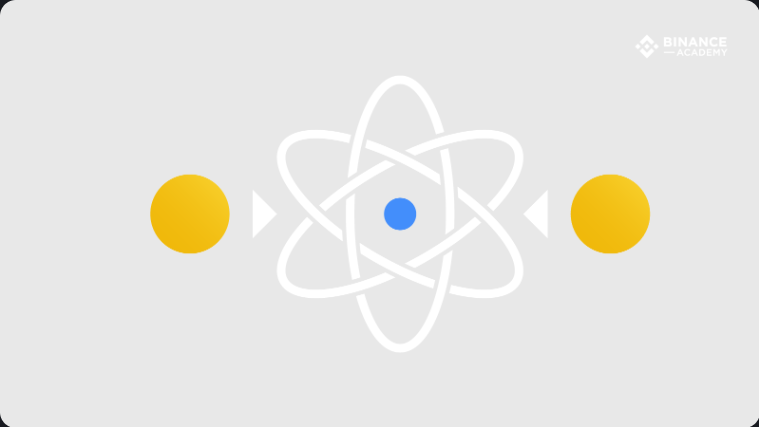
What is an Atomic Swap?
Atomic swaps are a technology that enables the rapid exchange of two cryptocurrencies operating on different blockchain networks. This transaction process (also known as atomic cross-chain trading) is based on smart contracts, allowing users to directly swap desired tokens from their crypto wallets. Therefore, atomic swaps are essentially cross-chain peer-to-peer transactions.
Although this technology is innovative, the concept of cross-chain trading has been around for years. In 2013, Tier Nolan first provided a detailed description of the atomic swap protocol. However, Daniel Larimer proposed a decentralized exchange protocol called P2PTradeX in 2012, which some consider the prototype of atomic swaps.
In the following years, many developers continued to experiment with atomic swap protocols. Evidence suggests that the Bitcoin, Litecoin, Komodo, and Decred communities played significant roles in this process.
The first peer-to-peer atomic swap transaction occurred in 2014. However, it wasn't until 2017 that the technology gained public acceptance, driven by successful exchanges between the LTC/BTC and DCR/LTC trading pairs.
How Do Atomic Swaps Work?
The atomic swap protocol is designed to effectively prevent fraudulent behavior between trading parties. To better understand how they work, let's assume Alice wants to exchange her Litecoin (LTC) for Bob's Bitcoin (BTC).
First, Alice deposits her LTC into a contract address, which functions like a safe. After creating this security measure, Alice generates a key to access it. She then shares the hashed value of this key with Bob. Note that Bob cannot access Alice's LTC at this point because he only has the hashed value of the key, not the key itself.
Next, Bob uses the hash provided by Alice to create another secure contract address to deposit his BTC. If Alice wants to exchange BTC, she must use the same key for this address while simultaneously revealing the LTC key to Bob (using the special function of hashlock). This means that once Alice requests the BTC, Bob can simultaneously receive Alice's LTC, completing the atomic swap transaction.
The term "atomic" represents the consistency of the transaction—it either fully succeeds or fails entirely. If either party abandons the transaction or fails to act as expected, the contract is canceled, and the funds are automatically returned to their original owners.
Atomic swaps can be conducted in two different ways: on-chain and off-chain. On-chain atomic swaps occur on the blockchain network of either cryptocurrency (in the above case, on the Bitcoin and Litecoin blockchains). Off-chain atomic swaps, on the other hand, occur off the chain. These swaps typically rely on bidirectional payment channels, similar to those used in the Lightning Network.
Technically, most decentralized trading systems are completed using smart contracts based on multi-signature and Hashed Timelock Contracts (HTLC).
Hashed Timelock Contracts (HTLC)
Hashed Timelock Contracts (HTLC) are a critical component of Bitcoin's Lightning Network and are also one of the key elements of atomic swaps. As the name suggests, they rely on two key functions: hashlock and timelock.
Hashlock freezes the use of funds unless the relevant key data (Alice's key in the above example) is revealed. Timelock ensures the smart contract is executed only within a predetermined timeframe. Thus, HTLC eliminates the need for centralization, creating specific rules to prevent partial execution of atomic swaps.
Advantages
The biggest advantage of atomic swaps lies in their decentralization. Atomic swaps eliminate the need for centralized exchanges and any other intermediaries, enabling cross-chain exchanges between two or more parties without requiring mutual trust. Since users don't need to provide funds to centralized exchanges or third parties, the security level is significantly improved. Transactions can be initiated directly from users' personal wallets.
Additionally, this form of peer-to-peer trading incurs very low or no fees, resulting in lower operational costs. Lastly, atomic swaps enable faster transactions, offering higher interoperability. In other words, they allow various altcoins to be exchanged directly without using Bitcoin or Ethereum as intermediaries.
Limitations
Atomic swaps also require certain prerequisites, which may pose major obstacles to their widespread adoption. For example, to execute an atomic swap, the blockchains of the two cryptocurrencies must use the same hashing algorithm (e.g., both using Bitcoin's SHA-256). Additionally, they must be compatible with HTLC and other programmable features.
Moreover, atomic swaps raise privacy concerns. Since on-chain transactions can be easily tracked using blockchain explorers, user addresses can be easily obtained. A short-term solution to this issue is using privacy-focused cryptocurrencies to reduce exposure. Nonetheless, many developers are exploring the use of digital signatures in atomic swaps as a more reliable solution.
Why Are Atomic Swaps Important?
Atomic swaps have significant potential to improve the cryptocurrency space, though they have yet to be tested on a large scale. Cross-chain trading could ultimately solve many problems associated with centralized exchanges. While these exchanges currently sustain cryptocurrency operations, they still face several issues, including:
Major security threats: Centralized exchanges hold high-value resources unilaterally, making them more vulnerable to hacking. They are prime targets for digital currency hijacking.
Poor fund management and human error: Centralized exchanges require human operation. If key managers make mistakes or decision-makers make poor operational choices, users' funds are at risk.
High operational costs: Centralized exchanges charge high withdrawal and trading fees.
Inefficiency due to surging trading volume: When market activity spikes, centralized exchanges often struggle to handle the increased demand, leading to slow systems or service unavailability.
Regulation: Cryptocurrency regulations are strict in most countries. Government approval and oversight remain uncertain.
Conclusion
Although atomic swaps are still a relatively new technology with inherent limitations, they hold transformative potential for blockchain interoperability and cross-chain trading. Thus, this technology could significantly impact the cryptocurrency industry, opening new avenues for decentralized, peer-to-peer currency exchanges. Atomic swaps may see increasing adoption in the near future, particularly within decentralized exchanges.
















